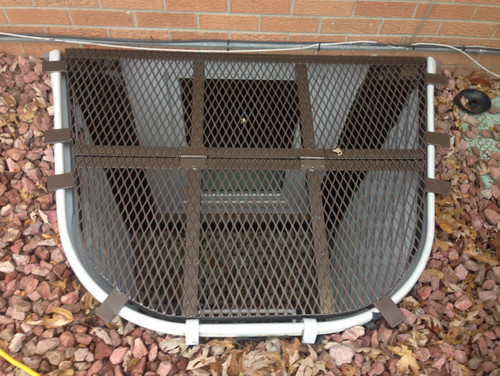There isn’t much not to like when it comes to adding an egress window. They increase the value of your home, and create a safer environment for everyone that lives under your roof.

Photo by Denver Egress Window – More basement photos
What is an egress window?
Egress windows are vital for the safety of your family.
Although smoke detectors are excellent warning devices, they are useless without a means of escape from your home.
An egress window is any window that provides a safe escape route from your home in case of fire, as well as an access point for rescue crews to gain access in case of fire or other emergency.
When converting a basement into a living area, of course, your family safety is a primary consideration. That’s why building codes specify that a finished basement must have an emergency egress window or door.
But an egress window can add comfort and transform your basement into a warm, inviting space, bringing natural light and fresh air inside of your new living space.
According to the most current residential building codes, not all basement rooms need a legal egress window, but certainly no basement bedrooms will be allowed without one. Today, any bedroom-sized room with a closet is considered a bedroom.
An egress window is also mandatory for “common-use” areas, such as game room, TV room, or office room.
Occasional-use spaces, such as bathrooms, laundry rooms, and utility areas, don’t need emergency egress.
Egress windows are also required to have minimum opening dimensions. The minimum open space width is 20-inches; the minimum height is 24 inches. In addition, the window sill—the bottom edge of the window—cannot be higher than 44 inches from the basement floor. If a deep basement forces a deeper window well, most codes will allow a concrete block on the floor of the well to serve as a step, as long as it doesn’t interfere with the window’s opening.
Bars, grills, screens or other obstructions placed over egress windows shall be releasable or removable from the inside without the use of a key or tool.
If you have a sloping yard, it may be that your new egress window can be installed completely above grade.
If your foundation walls barely peek above the soil line, however, you’ll have to excavate down and provide a window well. For the safety of your family when you are gardening or playing outside, building codes also allow a metal grate, or a cover, typically hinged, to be placed across the window well opening to protect pets and people from falling in. Still, you must be able to remove or open the grate from inside or outside the window well without special tools in the event of an emergency. To facilitate drainage of the well, the construction may include installation of a perforated pipe covered over with washed gravel to carry excess water away from the well, window, and foundation wall.
Installation of an egress window:
Tools: concrete saw; hammer drill; hammer; chisel; concrete; lumber; level; safety glasses.
Select the Proper Location: To choose a location of the egress window is a very important thing because you need to cut a hole in foundation of your house. You need to know where is more convenient for you, how your window will look from the outside and what are the exterior obstacles (shrubs, electrical wires, gas pipes, water pipes and duct work).
Cut the Hole: First, dig a large hole next to the foundation that’s at least 6 in. deeper than the bottom of the future window and about 48 in. square. Your hole should be large enough to fit your entire window and frame.
Outline your proposed window size (frame) with masking tape on the wall to get a feel for the placement and size of your window. Add in space for the header, if you place the window perpendicular to the floor joists. Then, use a concrete demolition saw to make the cuts. Begin cutting your hole from the inside. The first step in cutting your window’s rough opening involves drilling a pilot hole. After your pilot hole is drilled, start cutting out your rough opening. Concrete saw is an unwieldy tool that creates a cloud of dust. So, you need to go slowly and to wear protection eye glasses. Because some basement walls are thicker than others, this should be done carefully. A diamond blade is necessary and if you use the electric saw, especially if you wet the blade, plug it into a GFCI outlet to protect yourself from electrical shocks.
Complete the cut from the outside: After you have completed the cut from the inside, go outside and repeat the same step on your outer wall until your hole is cut. You may need to chip away rough spots with a hammer and chisel.
With the opening cut on both sides, start tapping the upper blocks with a 4-lb hammer until they either break loose whole or crumble in pieces. When you’ve removed all the blocks and chiseled away any obstructing mortar, build the pressure-treated box to fit the opening. Apply construction adhesive to those surfaces of the opening that will mate with the box. Anchoring the rough frame box to the block can be tricky. Mark the block where the concrete screws can get a good bite into solid concrete. Don’t try to draw the side frames tight to the wall with the screws. Use shims when tightening the screws to keep the frame straight and plumb (perfectly vertical). Press the box in place so that its outer edge is flush with the outside of the block wall.
Install the window: When you install the window you have to read carefully the manufacture instructions. If you measured properly, your window should fit into the frame. Before you place the window in the frame, seal any gaps in the frame with polyurethane.
Be sure to shim the window so it fits snugly. Secure the window and affix it to the frame. After you have leveled the window, screw it to the edge of the frame through the nail fins on your window unit. After you have screwed your window onto the frame, examine it for gaps. Fill these gaps with caulk and smooth them. Your window is now hung.
The Finish: The trim work will vary according to the style of your home. The exterior finish could pose some problems because most foundation walls are coated with rubbery tar below the soil level. And to complete the work you have to set the window well.
Dig Out a Basement in an Existing House – Tips and Ideas (howtobuildahouseblog.com)


